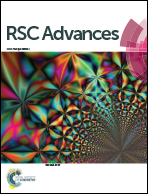Development of novel inorganic–organic hybrid nanocomposites as a recyclable adsorbent and catalyst†
Abstract
Development of novel inorganic–organic hybrid nanocomposites based on the immobilization of nanoparticles on tubular clay minerals has received a lot of attention not only because of their abundance in nature and their low cost but also because they can be utilized as catalysts, as a nanoreactor to host reactants for nanosynthesis, and for the controlled release of bio-molecules. Halloysite nanotube (HNT), an important inorganic material, possesses a hollow tubular structure. Here, we demonstrate a method for the selective modification of the outer surface of the HNTs with an organosilane to make HNTs a novel solid-phase adsorbent to extract heavy metal ions from aqueous solutions. The new functionalized HNTs exhibit excellent selectivity for the extraction of mercury which shows monolayer molecular adsorption over HNTs and the adsorption of Hg(II) follows pseudo-second order kinetics. Following the surface modification of HNTs, a two-step procedure has been developed to fabricate metal/HNT nanocomposites. With the commercially available reagents, monodispersed Au, Ag, and AuAg alloy nanoparticles (NPs) were synthesized in a hot organoamine solvent under a nitrogen atmosphere using a standard air-free technique. Metal/HNT nanocomposites are obtained by the immobilization of preformed metal NPs on HNT surfaces where the organosilane behaves as a linker molecule. Finally, the catalytic activity of these nanocomposites was determined and their use was compared in the production of anthranilic acid.


 Please wait while we load your content...
Please wait while we load your content...